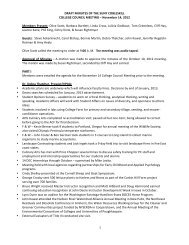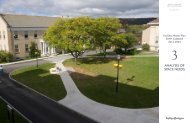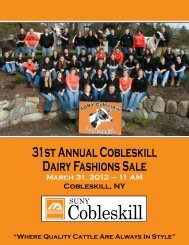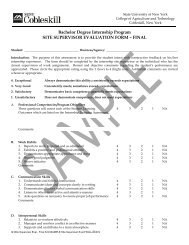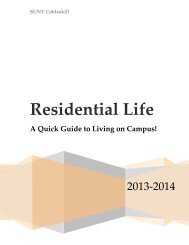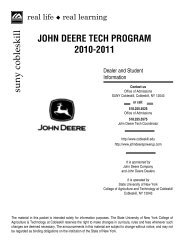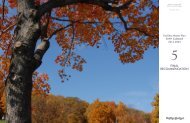Part 1: Campus Profile - SUNY Cobleskill
Part 1: Campus Profile - SUNY Cobleskill
Part 1: Campus Profile - SUNY Cobleskill
Create successful ePaper yourself
Turn your PDF publications into a flip-book with our unique Google optimized e-Paper software.
<strong>SUNY</strong> <strong>Cobleskill</strong> Facilities Master Plan – Phase 1 Report<br />
November 2011<br />
PHYSICAL ENVIRONMENT<br />
G<br />
G – PHYSICAL ENVIRONMENT<br />
<strong>SUNY</strong> <strong>Cobleskill</strong> is located in the Village of <strong>Cobleskill</strong> in New York’s<br />
Schoharie County, a picturesque and historic area approximately 160<br />
miles northwest of New York City and midway between Albany and<br />
Oneonta. NYS Route 7 runs through the middle of the campus at the<br />
western edge of the Village of <strong>Cobleskill</strong>, directly off of I-88.<br />
Schoharie County offers a rare combination of rural life and direct access<br />
to the services and activities of a metropolitan area, New York’s Capital<br />
Region. Albany is only a 40-minute drive east of the College. The county<br />
lies in close proximity to such natural splendors as the Adirondack Park,<br />
the Catskill Mountains, the historic Helderberg Mountains, and the<br />
Mohawk Valley. State and private parks, streams, lakes, mountain trails<br />
and ski areas provide an abundance of outdoor activities.<br />
PHYSICAL CONTEXT<br />
era, when a vast slurry of limestone coursed through the region. This<br />
has given rise to areas of irregular limestone known as “Karst,” in which<br />
caves, fissures, joints, sinkholes, depressions, springs (“resurgences”), and<br />
sinking streams (“insurgences”) are found, including the nearby tourist<br />
attraction known as the Howe Caverns. In these areas, water passes<br />
quickly through solutional passages, but does not purify itself in doing so<br />
as it would through more consolidated and organic strata. These areas<br />
are therefore vulnerable to pollution from agricultural and development<br />
uses of land (cattle pastures, trash dumps, septic tanks, etc). The Town<br />
of <strong>Cobleskill</strong> has concluded that the best environmental solution lies in<br />
preserving farmland, which in turn raises issues of entrepreneurship that<br />
are central to <strong>SUNY</strong> <strong>Cobleskill</strong>’s focus on agribusiness. The Protection<br />
Plan identifies several key strengths and weaknesses which appear to be<br />
areas in which <strong>SUNY</strong> <strong>Cobleskill</strong> could both assist and benefit the region.<br />
Cambrian<br />
Middle Proterozoic<br />
Ordovician<br />
Silurian<br />
Devonian<br />
Graphic G1<br />
Bedrock Geology of New York<br />
State<br />
The Village of <strong>Cobleskill</strong>, with approximately 5,300 residents, is a typical<br />
small college town with convenient access to shopping, dining, houses of<br />
worship, recreational facilities, and medical services. With a history that<br />
dates to 1711 (when the first pioneer settlers arrived), the <strong>Cobleskill</strong> area<br />
is a treasure trove of historic sites and museums.<br />
Late Proterozoic<br />
Cambrian - Late Ordivician<br />
Middle Proterozoic<br />
Triassic<br />
Cretaceous<br />
The Village of <strong>Cobleskill</strong> was founded in 1752, while the Town was<br />
established in 1797. Key historic structures such as the Bulls Head Inn<br />
(1802), the oldest building in the Village, remain. Over the course of<br />
the 19th century, the Village evolved from a small village on a stream to<br />
a prosperous and bustling town with the arrival of the railroad. Historic<br />
images on postcards illustrate tree-lined streets with an urban, small-town<br />
presence and a major railroad station as early as 1900. The Village’s<br />
Main Street continues through the center of the campus (renamed as<br />
Albany Street).<br />
Given <strong>SUNY</strong> <strong>Cobleskill</strong>’s distinctive focus on land, agriculture, and<br />
natural resources, and its commitment to environmental issues and to<br />
partnerships with local and regional interests, it is interesting to note that<br />
<strong>Cobleskill</strong> lies in a unique geological area with significant implications for<br />
farming and the environmental health of its region. According to the Town<br />
of <strong>Cobleskill</strong> Agricultural and Farmland Protection Plan, <strong>Cobleskill</strong> lies on<br />
the edge of a large region to the south that is geologically composed of<br />
Marcellus Shale, a marine sedimentary rock that is a potential source of<br />
natural gas obtained through the controversial process of “fracking.”<br />
To the north, extending in a broad arc from the Hudson west to Michigan,<br />
is an area of unusual geological formations created during the Devonian<br />
St. Lawrence-Champlain Lowlands<br />
Adirondack Mountains<br />
Tug Hill Plateau<br />
Ontario Lowlands<br />
Allegheny Plateau<br />
Catskill Mountains<br />
Hudson Highlands<br />
Newark Lowlands<br />
Atlantic Coastal Plain<br />
Mohawk Valley<br />
Taconic<br />
Mountains<br />
Hudson Valley<br />
Manhattan<br />
Prong<br />
Graphic G2<br />
Physiographic Provinces of New<br />
York State<br />
29



